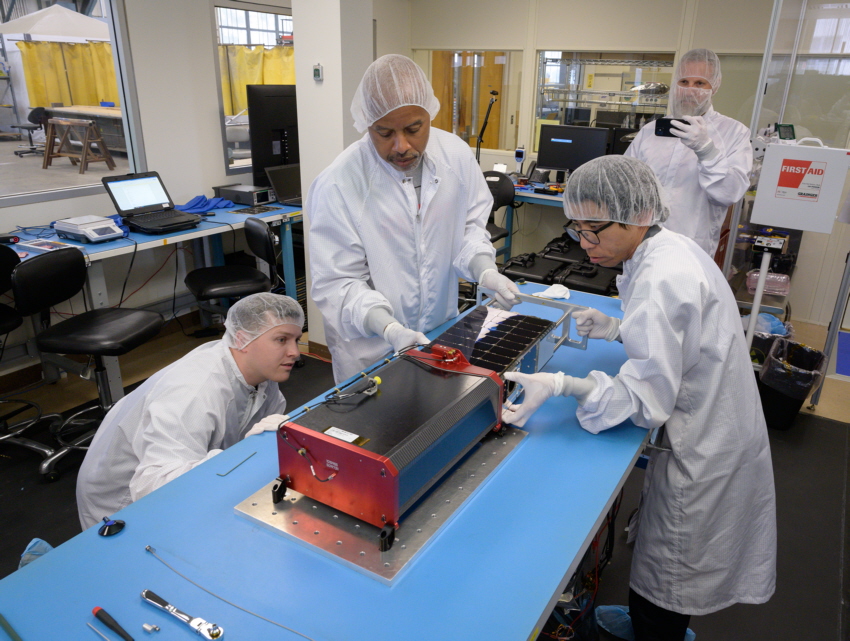

NASA Ames Research Center News Release
2023 July 5

Watson Attai of Axient-MEIS, Starling integration and testing lead, right; Jeff Blair, Starling lead mechanical engineer, center; and Nick Gentz, Rocket Lab payload integration engineer, left, load a Starling spacecraft into a Rocket Lab CubeSat dispenser as Damon Flansburg, Starling chief safety officer, observes at NASA's Ames Research Center in California's Silicon Valley. Credits: NASA/ Dominic Hart
A quartet of six-unit (6U) CubeSats will show off their moves in a sort of orbital line dance when NASA's Starling mission tests critical swarm technologies in space. The spacecraft are planned to launch no earlier than July 14 aboard Rocket Lab's Electron rocket from Rocket Lab's Launch Complex 1 facility in Mahia, New Zealand.
Future autonomous spacecraft swarms could change the way NASA conducts science and exploration missions. Spacecraft swarms operating at great distances from the Earth must carry out functions on their own, due to the time delay in communicating with ground stations and potential communications disruptions. Autonomy will ensure that a mission continues to perform even when communications with spacecraft are temporarily disrupted. Additionally, autonomy allows spacecraft swarms to change behavior to observe unexpected or infrequent phenomena - referred to by researchers as “opportunistic science.”
Once positioned about 355 miles above Earth and spaced about 40 miles apart, Starling's spacecraft will demonstrate the ability to autonomously fly together while keeping track of each other's relative positions and trajectories. They also will demonstrate the ability to plan and execute activities as a group, without guidance from mission controllers, including responding to new information from onboard sensors. Starling's spacecraft will also demonstrate creating and maintaining an inter-spacecraft communications network that automatically adjusts to changing conditions. If one spacecraft communications node fails, the network automatically reconfigures to maintain full communication capabilities for the remaining operational spacecraft in the swarm.
NASA has partnered with American academic institutions and small businesses to provide key technologies and support mission operations for Starling's technology demonstration. Partners include small businesses from NASA's Small Business Innovation Research (SBIR) program, which provides early-stage funding and ongoing support for research, development, and demonstration of innovative technologies that fulfill NASA needs. These partnerships will advance space exploration capabilities and create jobs through the growth of commercial space companies that will both use and provide new technologies.
In this photo engineers from NASA's Ames Research Center in California's Silicon Valley and Rocket Lab USA, Inc., of Long Beach, California recently teamed up at NASA Ames to integrate Starling's four spacecraft into Rocket Lab CubeSat dispensers ahead of launch. The spacecraft, each about the size of two stacked cereal boxes, were provided by Blue Canyon Technologies of Boulder, Colorado.
NASA Ames leads the Starling project. NASA's Small Spacecraft Technology program, based at NASA Ames and within NASA's Space Technology Mission Directorate (STMD), funds and manages the Starling mission. Blue Canyon Technologies designed and manufactured the spacecraft buses and is providing mission operations support. Rocket Lab USA, Inc. provides launch and integration services. Partners supporting Starling's payload experiments include Stanford University's Space Rendezvous Lab in Stanford, California, Emergent Space Technologies of Laurel, Maryland, CesiumAstro of Austin, Texas, L3Harris Technologies, Inc., of Melbourne, Florida, and NASA Ames - with funding support by NASA's Game Changing Development program within STMD.
Copyright © 2023, Brian Webb. All rights reserved.